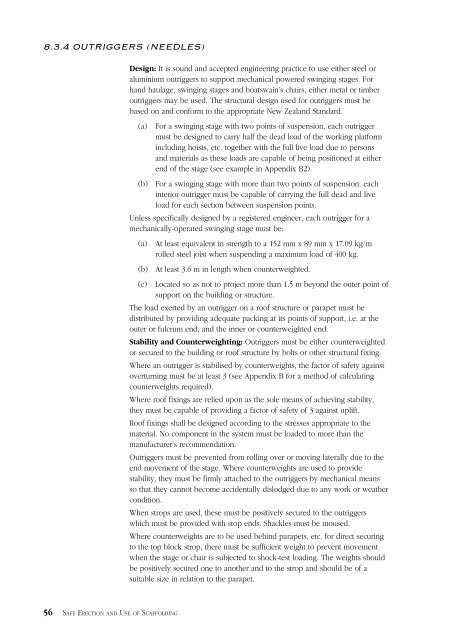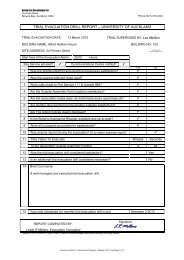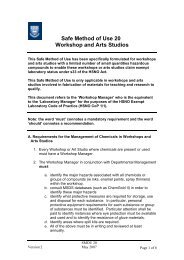Of for the safe erection and use of scaffolding
Of for the safe erection and use of scaffolding
Of for the safe erection and use of scaffolding
- No tags were found...
You also want an ePaper? Increase the reach of your titles
YUMPU automatically turns print PDFs into web optimized ePapers that Google loves.
8.3.4 OUTRIGGERS (NEEDLES)Design: It is sound <strong>and</strong> accepted engineering practice to <strong>use</strong> ei<strong>the</strong>r steel oraluminium outriggers to support mechanical powered swinging stages. Forh<strong>and</strong> haulage, swinging stages <strong>and</strong> boatswain’s chairs, ei<strong>the</strong>r metal or timberoutriggers may be <strong>use</strong>d. The structural design <strong>use</strong>d <strong>for</strong> outriggers must bebased on <strong>and</strong> con<strong>for</strong>m to <strong>the</strong> appropriate New Zeal<strong>and</strong> St<strong>and</strong>ard.(a)For a swinging stage with two points <strong>of</strong> suspension, each outriggermust be designed to carry half <strong>the</strong> dead load <strong>of</strong> <strong>the</strong> working plat<strong>for</strong>mincluding hoists, etc. toge<strong>the</strong>r with <strong>the</strong> full live load due to persons<strong>and</strong> materials as <strong>the</strong>se loads are capable <strong>of</strong> being positioned at ei<strong>the</strong>rend <strong>of</strong> <strong>the</strong> stage (see example in Appendix B2).(b) For a swinging stage with more than two points <strong>of</strong> suspension, eachinterior outrigger must be capable <strong>of</strong> carrying <strong>the</strong> full dead <strong>and</strong> liveload <strong>for</strong> each section between suspension points.Unless specifically designed by a registered engineer, each outrigger <strong>for</strong> amechanically-operated swinging stage must be:(a)(b)At least equivalent in strength to a 152 mm x 89 mm x 17.09 kg/mrolled steel joist when suspending a maximum load <strong>of</strong> 400 kg.At least 3.6 m in length when counterweighted.(c) Located so as not to project more than 1.5 m beyond <strong>the</strong> outer point <strong>of</strong>support on <strong>the</strong> building or structure.The load exerted by an outrigger on a ro<strong>of</strong> structure or parapet must bedistributed by providing adequate packing at its points <strong>of</strong> support, i.e. at <strong>the</strong>outer or fulcrum end, <strong>and</strong> <strong>the</strong> inner or counterweighted end.Stability <strong>and</strong> Counterweighting: Outriggers must be ei<strong>the</strong>r counterweightedor secured to <strong>the</strong> building or ro<strong>of</strong> structure by bolts or o<strong>the</strong>r structural fixing.Where an outrigger is stabilised by counterweights, <strong>the</strong> factor <strong>of</strong> <strong>safe</strong>ty againstoverturning must be at least 3 (see Appendix B <strong>for</strong> a method <strong>of</strong> calculatingcounterweights required).Where ro<strong>of</strong> fixings are relied upon as <strong>the</strong> sole means <strong>of</strong> achieving stability,<strong>the</strong>y must be capable <strong>of</strong> providing a factor <strong>of</strong> <strong>safe</strong>ty <strong>of</strong> 3 against uplift.Ro<strong>of</strong> fixings shall be designed according to <strong>the</strong> stresses appropriate to <strong>the</strong>material. No component in <strong>the</strong> system must be loaded to more than <strong>the</strong>manufacturer’s recommendation.Outriggers must be prevented from rolling over or moving laterally due to <strong>the</strong>end movement <strong>of</strong> <strong>the</strong> stage. Where counterweights are <strong>use</strong>d to providestability, <strong>the</strong>y must be firmly attached to <strong>the</strong> outriggers by mechanical meansso that <strong>the</strong>y cannot become accidentally dislodged due to any work or wea<strong>the</strong>rcondition.When strops are <strong>use</strong>d, <strong>the</strong>se must be positively secured to <strong>the</strong> outriggerswhich must be provided with stop ends. Shackles must be mo<strong>use</strong>d.Where counterweights are to be <strong>use</strong>d behind parapets, etc. <strong>for</strong> direct securingto <strong>the</strong> top block strop, <strong>the</strong>re must be sufficient weight to prevent movementwhen <strong>the</strong> stage or chair is subjected to shock-test loading. The weights shouldbe positively secured one to ano<strong>the</strong>r <strong>and</strong> to <strong>the</strong> strop <strong>and</strong> should be <strong>of</strong> asuitable size in relation to <strong>the</strong> parapet.56 SAFE ERECTION AND USE OF SCAFFOLDING
















